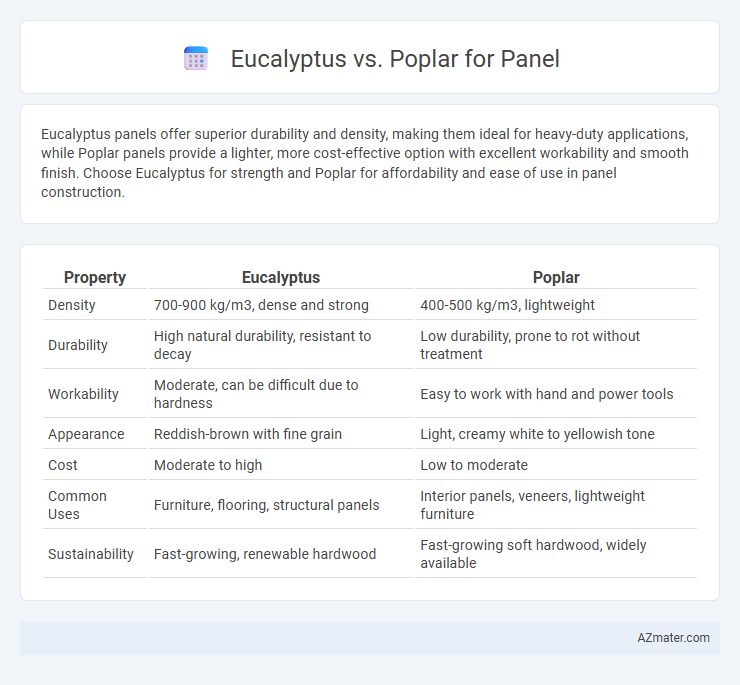Eucalyptus panels offer superior durability and density, making them ideal for heavy-duty applications, while Poplar panels provide a lighter, more cost-effective option with excellent workability and smooth finish. Choose Eucalyptus for strength and Poplar for affordability and ease of use in panel construction.
Table of Comparison
| Property | Eucalyptus | Poplar |
|---|---|---|
| Density | 700-900 kg/m3, dense and strong | 400-500 kg/m3, lightweight |
| Durability | High natural durability, resistant to decay | Low durability, prone to rot without treatment |
| Workability | Moderate, can be difficult due to hardness | Easy to work with hand and power tools |
| Appearance | Reddish-brown with fine grain | Light, creamy white to yellowish tone |
| Cost | Moderate to high | Low to moderate |
| Common Uses | Furniture, flooring, structural panels | Interior panels, veneers, lightweight furniture |
| Sustainability | Fast-growing, renewable hardwood | Fast-growing soft hardwood, widely available |
Introduction to Eucalyptus and Poplar as Panel Woods
Eucalyptus and Poplar are widely used hardwoods in panel manufacturing, valued for their distinct properties. Eucalyptus is known for its density, durability, and rapid growth, making it suitable for structural and decorative panels. Poplar offers a lighter, softer texture with good workability, often preferred for interior applications and furniture panels.
Botanical Overview: Eucalyptus vs Poplar
Eucalyptus trees belong to the Myrtaceae family, featuring fast growth and high density wood ideal for panel production, while Poplar, from the Salicaceae family, offers lightweight, softwood with moderate growth rates. Eucalyptus species have a higher cellulose content, enhancing panel strength and durability, whereas Poplar is prized for its uniform texture and ease of machining. The contrasting anatomical structures influence panel applications, with Eucalyptus providing superior rigidity and Poplar suitable for lighter, flexible uses.
Growth Rate and Sustainability Comparison
Eucalyptus exhibits a faster growth rate, often reaching maturity within 7 to 10 years, making it highly efficient for panel production compared to Poplar, which typically matures in 12 to 15 years. In terms of sustainability, Eucalyptus plantations require careful management to prevent soil degradation and water depletion, while Poplar demonstrates better tolerance to diverse soil conditions and contributes positively to soil health. Both species support sustainable forestry practices when harvested responsibly, but Poplar's adaptability and lower environmental impact often make it a preferred choice for eco-friendly panel manufacturing.
Wood Density and Strength Differences
Eucalyptus wood typically exhibits a higher density ranging from 600 to 900 kg/m3, providing superior strength and durability compared to Poplar, which has a lower density of approximately 400 to 550 kg/m3. This density difference translates into Eucalyptus panels offering enhanced load-bearing capacity and resistance to bending stress, making them ideal for structural applications. Poplar's lighter density results in panels that are easier to handle but less suitable for heavy-duty uses due to lower mechanical strength and stiffness.
Durability and Resistance to Pests
Eucalyptus wood exhibits superior durability and natural resistance to pests compared to Poplar, making it a more reliable option for panels exposed to harsh environments. Poplar is generally softer and more susceptible to insect attacks and fungal decay, requiring additional treatments for enhanced longevity. Eucalyptus's dense fiber structure and natural oils contribute significantly to its pest-resistant properties, extending the lifespan of wood panels.
Workability and Machining Properties
Eucalyptus wood offers moderate workability with a tendency to dull tools quickly due to its density, requiring sharp blades and slower feed rates during machining, while Poplar provides excellent workability characterized by ease of cutting, shaping, and sanding, making it ideal for precise panel applications. Machining Poplar results in smooth surfaces and minimal splintering, facilitating fine finishes, whereas Eucalyptus may produce rougher edges and requires additional sanding to achieve a comparable quality. The dimensional stability of Poplar panels typically surpasses that of Eucalyptus, reducing the risk of warping during processing and long-term use.
Aesthetic Qualities: Grain, Color, and Finish
Eucalyptus panels exhibit a fine, uniform grain with warm, reddish-brown hues providing a rich, natural aesthetic suited for modern interiors. Poplar panels feature a straighter, more subdued grain pattern with lighter cream to pale yellow tones, offering a smooth and consistent finish ideal for painted or stained applications. Both woods respond well to finishing treatments, but eucalyptus enhances character through natural color variation, while poplar delivers a clean, versatile backdrop.
Environmental Impact and Carbon Sequestration
Eucalyptus panels offer rapid growth rates and high biomass yield, enhancing carbon sequestration compared to poplar, which grows slower but supports greater biodiversity in plantation ecosystems. Eucalyptus plantations may lead to soil nutrient depletion and water resource stress, whereas poplar trees contribute to improved soil quality and reduced erosion, making them a more sustainable option in sensitive environments. Both species effectively sequester carbon in panel products, but poplar's environmental balance and ecosystem services present lower ecological risks over long-term cultivation.
Cost Analysis and Accessibility
Eucalyptus panels generally offer lower initial costs due to faster growth rates and higher yield per hectare compared to poplar, making them an economically attractive option for large-scale production. Poplar panels tend to have higher accessibility in temperate regions due to established plantations and better availability of raw materials, which can reduce transportation expenses. Cost analysis favors eucalyptus for budget-conscious projects while poplar remains competitive where local supply chains and infrastructure support its procurement.
Best Applications for Eucalyptus and Poplar Panels
Eucalyptus panels perform exceptionally well in heavy-duty applications such as flooring, furniture, and structural uses due to their high density, durability, and natural resistance to wear and moisture. Poplar panels are ideal for interior furniture, cabinetry, and decorative plywood where smooth surface finish, light weight, and ease of machining are critical. Both wood types offer reliable strength, but Eucalyptus excels in demanding environments while Poplar is favored for aesthetic and lightweight construction.

Infographic: Eucalyptus vs Poplar for Panel
 azmater.com
azmater.com